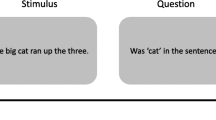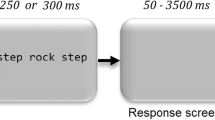Abstract
Word is important in Chinese reading. However, when inter-word spaces are inserted into Chinese text, there is no facilitation or disruption to adults’ reading. Researchers argued that there was a trade-off between word segmentation facilitation and disruption due to format unfamiliarity. To assess the trade-off hypothesis, in Experiment 1, we tested Grade 1, 2 and 3 children who have less reading experience than adults and manipulated four spacing conditions: normal unspaced, word spaced, character spaced, and nonword spaced text. In Experiment 2, we collected data from Grade 1 and 3 with the word spaced condition and normal unspaced condition. Overall, global analyses from both Experiments consistently showed that word spacing facilitated Grade 1 reading, with much reduced facilitation for higher grade readers; local measures (total reading time and second-pass reading time) replicated the same pattern in which word spacing effects were more pronounced among younger readers. In summary, we obtained greater facilitatory effects of word spacing for younger compared with elder readers, which provides strong evidence for the trade-off hypothesis.
Similar content being viewed by others
Notes
Reading fluency test as the measure of reading ability has been used in previous studies (Lei et al., 2011; Liu et al., 2020; Yan et al., 2021). Therefore, in the present study, we also used reading fluency test to compare the reading ability for different grades. In this test, children were required to read sentences silently as quickly as they could and to judge whether the sentence was correct during a 3-min interval (see the paper of “What Is in the Naming? A 5-Year Longitudinal Study of Early Rapid Naming and Phonological Sensitivity in Relation to Subsequent Reading Skills in Both Native Chinese and English as a Second Language.”). There was 3 practice sentences and 100 test sentences in total; these were arranged by length of the sentences, and the meanings were familiar to children. For example, “太阳从西边升起 ( ×)” (Translation: The sun rise in the west). In Experiment 1, the reading fluency test score were 105.2 characters/min, 159.2 characters/min, 290.5 characters/min for G1, G2, G3 respectively, and the internal consistency coefficient alpha was 0.97. In Experiment 2, the score was 87.6 characters/min, 274.1 characters/min for G1 and G3 respectively, and the internal consistency coefficient alpha was 0.98.
References
Bai, X., Guo, Z., Gu, J., Cao, Y., & Yan, G. (2011). Effect of word segmentation cues on Japanese-Chinese bilingual’s Chinese reading: Evidence from eye movements. Acta Psychologica Sinica, 43(11), 1273–1282.
Bai, X., Liang, F., Blythe, H. I., Zang, C., Yan, G., & Liversedge, S. P. (2013). Interword spacing effects on the acquisition of new vocabulary for readers of Chinese as a second language. Journal of Research in Reading, 36, 4–17.
Bai, X., Yan, G., Liversedge, S. P., Zang, C., & Rayner, K. (2008). Reading spaced and unspaced Chinese text: Evidence from eye movements. Journal of Experimental Psychology: Human Perception and Performance, 34, 1277–1287.
Bates, D., Mächler, M., Bolker, B., & Walker, S. (2015). Fitting linear mixed-effects models using lme4. Journal of Statistical Software, 67(1), 1–48.
Blythe, H. I., Liang, F., Zang, C., Wang, J., Yan, G., Bai, X., & Liversedge, S. P. (2012). Inserting spaces into Chinese text helps readers to learn new words: An eye movement study. Journal of Memory and Language, 67, 241–254.
Blythe, H. I., & Joseph, H. S. (2011). Children’s eye movements during reading. In S. P. Liversedge, I. D. Gilchrist, & S. Everling (Eds.), Oxford library of psychology. The Oxford handbook of eye movements (pp. 643–662). Oxford University Press.
Chen, M., Wang, Y., Zhao, B., Li, X., & Bai, X. (2021). The trade-off between format familiarity and word-segmentation facilitation in Chinese reading. Frontiers in Psychology, 12, 602931.
Drieghe, D., Fitzsimmons, G., & Liversedge, S. P. (2017). Parafoveal preview effects in reading unspaced text. Journal of Experimental Psychology: Human Perception and Performance, 43(10), 1701–1716.
Häikiö, T., Bertram, R., Hyönä, J., & Niemi, P. (2009). Development of the letter identity span in reading: Evidence from the eye movement moving window paradigm. Journal of Experimental Child Psychology, 102, 167–181.
Kuznetsova, A., Brockhoff, P. B., & Christensen, R. H. B. (2017). LmerTest package: Tests in linear mixed effects models. Journal of Statistical Software, 82(13), 1–26.
Li, X., & Shen, W. (2013). Joint effect of insertion of spaces and word length in saccade target selection in Chinese reading. Journal of Research in Reading, 36, 64–77.
Liu, P., & Li, X. (2014). Inserting spaces before and after words affect word processing differently: Evidence from eye movements. British Journal of Psychology, 105, 57–68.
Liu, P., & Lu, Q. (2017). The effects of spaces on word segmentation in Chinese reading: Evidence from eye movements. Journal of Research in Reading, 41(2), 329–349.
Ma, G. (2017). Does interword spacing influence lexical processing in Chinese reading? Visual Cognition, 25(7–8), 815–824.
Ma, G., Li, D., & Zhuang, X. (2019). Do visual word segmentation cues improve reading performance in Chinese reading? Ergonomics, 62(8), 1086–1097.
Milledge, S. V., Blythe, H. I., & Liversedge, S. P. (2020). Parafoveal pre-processing in children reading English: The importance of external letters. Psychonomic Bulletin & Review, 28(1), 197–208.
Perea, M., & Acha, J. (2009). Space information is important for reading. Vision Research, 49, 1994–2000.
Perea, M., & Wang, X. (2017). Do alternating-color words facilitate reading aloud text in Chinese? Evidence with developing and adult readers. Memory Cognition, 45(7), 1160–1170.
Rayner, K., Fischer, M. H., & Pollatsek, A. (1998). Unspaced text interferes with both word identification and eye movement control. Vision Research, 38, 1129–1144.
Sainio, M., Hyöna, J., Bingushi, K., & Bertram, R. (2007). The role of interword spacing in reading Japanese: An eye movement study. Vision Research, 47, 2575–2584.
Shen, D., Bai, X., Zang, C., Yan, G., Feng, B., & Fan, X. (2010). Effect of word segmentation on beginners’ reading: Evidence from eye movements. Acta Psychologica Sinica, 42, 159–172.
Shen, D., Liversedge, S. P., Tian, J., Zang, C., Cui, L., Bai, X., Yan, G., & Rayner, K. (2012). Eye movements of second language learners when reading spaced and unspaced Chinese text. Journal of Experimental Psychology: Applied, 18(2), 192–202.
Sheridan, H., Rayner, K., & Reingold, E. M. (2013). Unsegmented text delays word identification: Evidence from a survival analysis of fixation durations. Visual Cognition, 21, 38–60.
Sheridan, H., Reichle, E. D., & Reingold, E. M. (2016). Why does removing inter-word spaces produce reading deficits? The role of parafoveal processing. Psychonomic Bulletin & Review, 23(5), 1543–1552.
Song, Z., Liang, X., Wang, Y., & Yan, G. (2021). Effect of alternating-color words on oral reading in grades 2–5 Chinese children: Evidence from eye movements. Reading and Writing. https://doi.org/10.1007/s11145-021-10164-3
Song, S., Su, M., Kang, C., Liu, H., Zhang, Y., Mcbride-Chang, C., et al. (2015). Tracing children’s vocabulary development from preschool through the school-age years: An 8-year longitudinal study. Developmental Science, 18(1), 119–131.
Sperlich, A., Meixner, J., & Laubrock, J. (2016). Development of the perceptual span in reading: A longitudinal study. Journal of Experimental Child Psychology, 146, 181–201.
Sperlich, A., Schad, D. J., & Laubrock, J. (2015). When preview starts to matter: Development of the perceptual span in German beginning readers. Journal of Cognitive Psychology, 27(5), 511–530.
Tiffin-Richards, S. P., & Schroeder, S. (2015). Children’s and adults’ parafoveal processes in German: Phonological and orthographic effects. Journal of Cognitive Psychology, 27(5), 531–548.
Winskel, H., Radach, R., & Luksaneeyanawin, S. (2009). Eye movements when reading spaced and unspaced Thai and English: A comparison of Thai-English bilinguals and English monolinguals. Journal of Memory and Language, 61, 339–351.
Zang, C., Liang, F., Bai, X., Yan, G., & Liversedge, S. P. (2013). Interword spacing and landing position effects during Chinese reading in children and adults. Journal of Experimental Psychology: Human Perception and Performance, 39(3), 720–734.
Acknowledgements
The research was supported by Humanity and Social Science Youth Foundation of Ministry of Education of China (Grant No. 18YJC190023).
Author information
Authors and Affiliations
Corresponding author
Additional information
Publisher's Note
Springer Nature remains neutral with regard to jurisdictional claims in published maps and institutional affiliations.
Rights and permissions
About this article
Cite this article
Li, S., Wang, Y., Lan, Z. et al. Effects of word spacing on children’s reading: Evidence from eye movements. Read Writ 35, 1019–1033 (2022). https://doi.org/10.1007/s11145-021-10215-9
Accepted:
Published:
Issue Date:
DOI: https://doi.org/10.1007/s11145-021-10215-9




